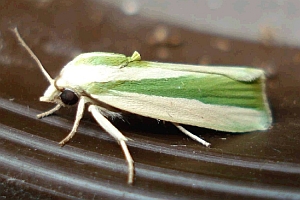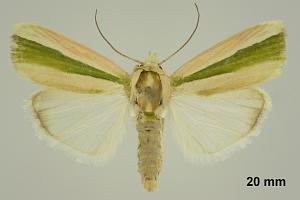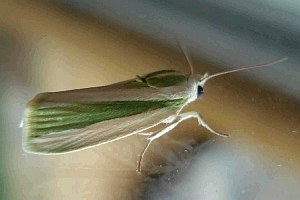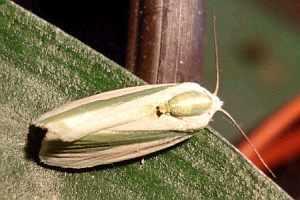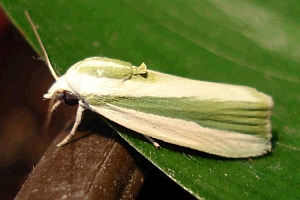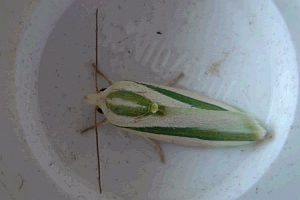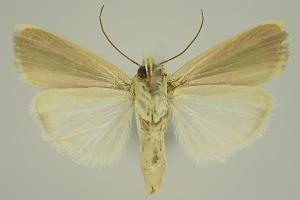 E
E
 +5Kontinente:EUASOC
+5Kontinente:EUASOC1. Lebendfotos
1.1. Falter
2. Diagnosis
2.1. Male
2.2. Erstbeschreibung
3. Weitere Informationen
3.1. Andere Kombinationen
- Tinea vittella Fabricius, 1794 [Originalkombination]
3.2. Synonyme
- Phalaena fabia Stoll, [1781]
- Aphusia speiplena Walker, [1858]
- Micra partita Walker, 1865
- Earias huegeli Rogenhofer, 1870
3.3. Faunistik
Earias vittella lebt im tropischen und subtropischen Ostasien (locus typicus ist der Osten Indiens) und nahen Australien, wo sie als gefürchteter Baumwollschädling gilt. Auf UKmoths wird von einem Falterfund in Dorset (Großbritannien) im Juni 2003 berichtet, ein weiterer Fund aus Südspanien wird auch erwähnt. Hier wird die Art jetzt erstmals aus Mitteleuropa (Deutschland) mitgeteilt:
Am 12. Juni 2010 meldet M. C. Melchior [Lepiforums-Beitrag M. C. Melchior, 12. Juni 2010]: "Ich habe heute an meiner Lichtfalle in Gundelfingen (Breisgau) eine Earias vittella gefangen. Ich hab gelesen, dass sie eigentlich aus Asien und Australien kommt, aber mit Holz u.ä. von dort mit dem Flugzeug nach Europa kommen kann. Ich hab von wenigen englischen und spanischen Nachweisen gelesen. Gibt es Nachweise aus Deutschland? Sollte sie, auch wenn sie sich evtl nicht hier vermehrt in die Bestimmungshilfe aufgenommen werden?" Am Tag darauf folgten die Bilder (siehe oben). Es handelte sich anscheinend tatsächlich um den Erstnachweis für Deutschland, und bemerkenswert daran ist vor allem, dass der Falter nicht auf einem Flugplatz oder im Großhandel gefunden wurde, sondern in einem Wohngebiet ans Licht flog. An der Tatsache, dass die Art in Europa sicher nirgends bodenständig ist, ändert dieser Fund nichts. Wir nehmen die Art hier dennoch mit Symbol "Einzelfund" in die Bestimmungshilfe auf, da es durchaus möglich ist, dass das Tier auch einmal andernorts gefunden wird: wir ermöglichen die Bestimmung und freuen uns dafür an der Meldung.
E. vittella gilt in Ostasien als Schädling an Baumwolle (Gossypium hirsutum und andere Arten der Gattung), Okra (Abelmoschus esculentus) und anderen Früchten und Blüten aus der Familie der Malvengewächse (Malvaceae). Da die Raupen in den Früchten dieser Pflanzen leben, wurden sie auch immer wieder einmal per Flugzeug nach Europa geschleppt, wo es aber anscheinend (noch) nie zu einer temporären Ansiedlung kam.
Heath & Emmet (1983): berichten aus England: "Early stages not known in Britain except as airport intercepts (Seymour, 1978). Larvae and pupae were found in each month from February to May 1976 at Heathrow Airport in association with okra pods (Abelmoschus esculentus) imported from India (Seymour, loc. cit.). They may also have been among other Earias larvae not identified to species level with similar association in 1978 and later. Imago. Not yet found in Britain, but might emerge from imported pupa." Auf ukmoths [Earias vittata auf ukmoths] ist dazu zu lesen: "The larva of this species has been found several times in okra (Abelmoschus esculentus) pods, imported from India. Until recently there had been no record of the adult occuring in Britain, until Steve Nash took the specimen illustrated at light in Dorset in June 2003. This occurred during a period of high migrant activity, suggesting the possibility of a genuine vagrant. Abroad, the species occurs throughout Asia and Australia, and an example has subsequently been identified from southern Spain." Der von Steve Nash gezeigte Falter ist völlig frisch - dass er aus Ostasien nach England geflogen sein soll, ist ganz und gar unglaubhaft. Agassiz et al. (2013: 112) führen die Art bei den "adventive species" und schreiben zu England: "Occasionally imported as larvae and pupae with okra and suspected immigrant. Asian/ Australian."
Kaaber (2011: 17-22) meldete ein zweifelsfrei als Raupe eingeschlepptes Exemplar aus Dänemark: "Earias vittella was found in tbe larval stage in the city of Aarhus in February 2010, being introduced with fresh okra-pods from India." Das Foto dieser Raupe, des Kokons und des geschlüpften Falters werden gezeigt.
Die Angabe aus Spanien wird von Vives Moreno (2014: 806) unter Anmerkung 1166 erläutert: "Esta especie fue capturada entre el 20 y el 28 de septiembre de 2001, en Estepona, Málaga, España (NASH, 2003)."
Bei Nash (2003: 187-188) heißt es zum Fund in England: "On the evening of 16 June 2003, a single example of Earias vittella was attracted to m.v. light at Durlston Country Park, Dorset. Immigrant moth activity was very high at that time [...] This appears to be not only the first occurence of a wild-caught moth in Britain, but also the first confirmed record in Europe (Michael Fibiger, pers. comm. via Colin Plant)." In der Diskusson wird zu früheren Beobachtungen aus Großbritannien gesagt: "Is has been recorded previously from Britain as larvae intercepted at Heathrow airport, Middlesexbetween February and June 1976, on Okra pods (Abelmoschus esculentus) imported from India (Seymur, 1978). It is an Old World tropical species (László Ronkay pers. comm., via Colin Plant), widespread and common throughout the Middle East, and from India to Australia." Und dann kann Nash (2003: 188) noch über den Nachweis aus Spanien berichten: "Shortly before going to press, I was informed by Jon Clifton that a specimen of E. vittella had be taken by him in Spain, but not identified until a photograph of the Svanage specimen was published on the Immigration of Lepidoptera web site (migrantmoth.com). He had collected that moth near Estapona, Málaga, Spain between 20 and 28 September 2001, and this would appear to be the earliest known European record." Er spekuliert weiter: "The possibility that the species is established in southern Spain, and that it was the source of the British example, should not be overlooked. Certainly an origination in southern Spain fits well with the general pattern of immigrant activity at the time and with species composition of the immigrants involved." Gegen diese Deutung spricht allerdings, dass die Art seit 2001 nie mehr aus Spanien gemeldet wurde - aber wer sucht auch schon in Baumwollpflanzungen nach Schmetterlingen ...
(Autor: Erwin Rennwald)
3.4. Literatur
- Agassiz, D.J.L., Beavan, S.D. & R.J. Heckford (2013): Checklist of the Lepidoptera of the British Isles. - Royal Entomological Society. 206pp.
- Erstbeschreibung: Fabricius, J. C. (1794): Entomologia systematica emendata et aucta. Secundum classes, ordines, genera, species adjectis synonimis, locis, observationibus, descriptionibus 3 (2): 1-349. Hafniae (C. G. Proft, Fil. et Soc.). — Digitalisat der Bayerischen Staatsbibliothek München: [293].
- Heath, J. & A. M. Emmet [ed.] (1983): The Moths and Butterflies of Great Britain and Ireland. Volume 10. Noctuidae (Cuculliinae to Hypeninae), Agaristidae. – 460 S.; Colchester (Harley Books).
- Kaaber, S. (2011)Tre anthropochore tropiske sommerfugle, Earias vittella (F.), E. biplaga Walker og E. insulana (Bsd.) (Lep. Nolidae, Earidinae) fundet i Danmark. — Flora og Fauna, Aarhus 117 (1): 17-22. [PDF (ganzes Heft) auf jydsknaturhistorisk.dk]
- Nash, S. (2003): Earias vittella (Fabricius) (Lep.: Noctuidae) the first occurence of wild-caught moths in Europe. — Entomologist’s Record and Journal of Variation, 115 (4): 187-188.
- Vives-Moreno (2014): Catálogo sistemático y sinonímico de los Lepidoptera de la Península Ibérica, de Ceuta, de Melilla y de las Islas Azores, Baleares, Canarias, Madeira y Salvajes (Insecta: Lepidoptera). — Suplemento de SHILAP Revista de Lepidopterología: 1-1184. Madrid.






